
Balsam Woolly Adelgid (Adelges piceae)
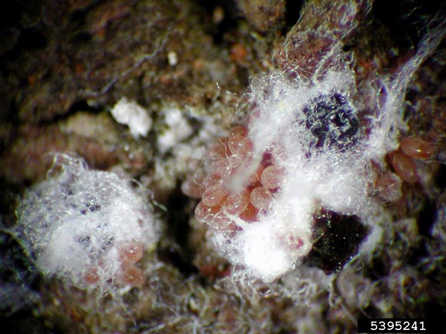
Balsam woolly adelgid (BWA) is an invasive insect from central Europe that feeds on all true fir trees (Abies spp.). This insect inserts its straw-like mouthparts into the trunk or branches of trees and feeds on the nutrient rich sap. It also injects toxic saliva into the tree which causes abnormal wood formation that disrupts the flow of water and nutrients throughout the tree. Swelling in the branches can lead to branch dieback and successive years of infestation may cause tree mortality. Severe stem infestations can cause tree mortality in two to three years.
Biology
Balsam woolly adelgid (BWA) has two generations per year and only females have been observed in North America, meaning reproduction is asexual. Adult BWA are very small (0.5-1.0 mm long), dark purple to black, oblong, and wingless. Female adults secrete a white, waxy substance that covers their body and eggs for protection. The wax is visible on the bark of host trees. Adult BWA are present and laying eggs in late spring. By early summer the eggs hatch into reddish-brown crawlers which is the only mobile life stage.
Crawlers disperse to new feeding sites on the same tree, or are transported by wind or animal to a new host tree. Once the crawlers begin feeding, they remain stationary and continue development into adults. Adults are again present and laying eggs in late summer and early fall. Eggs hatch and crawlers disperse to new feeding sites in late fall. Once these crawlers begin feeding they enter into their overwintering stage called neosistens. In early spring, the neosistens continue their development into the adult stage and most BWA are adults by late spring.
Where it’s from
Balsam woolly adelgid is native to central Europe and was first detected in North America around 1900. The United States first observed BWA in New England, but by the 1930s, it had been transported to the Pacific Northwest.
How it spreads
The only mobile life stage of BWA are the crawlers looking for new feeding sites or hosts. These crawlers are transported to other fir trees by wind or animals that brush against infested trees. Long distance transportation can occur through the movement of infested trees or wood.
Where it’s found
Since its initial detection in New England and northeast Canada, BWA has slowly been spreading throughout the United States. It is now present in at least 16 states including: Maine, New Hampshire, Vermont, New York, North Carolina, Virginia, West Virginia, Tennessee, California, Washington, Oregon, Idaho, Montana, Utah, Alaska, and Michigan.
What’s being done
Extensive research on BWA biology, effects and impacts, and management and control options has been done to date. The USDA, state governments, and universities are currently researching BWA in new environments, such as Utah where it was first discovered in 2017, as well as best silvicultural practices for managing infested trees. Detection surveys are performed regularly to monitor current infestations and scout for new ones.
Local governments are also providing outreach and education programs to teach property owners about identifying and managing BWA infestations. Currently, the only state in the U.S. with an active quarantine restricting the movement of true fir species is Michigan.
Images of BWA infestations and its damage
Early Balsam Woolly Adelgid:
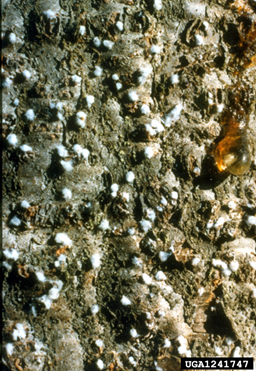
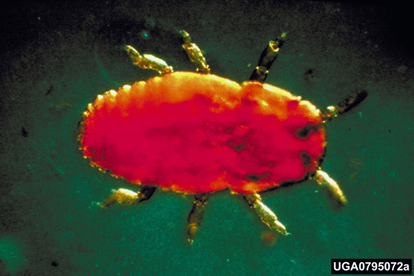
Older infestations:
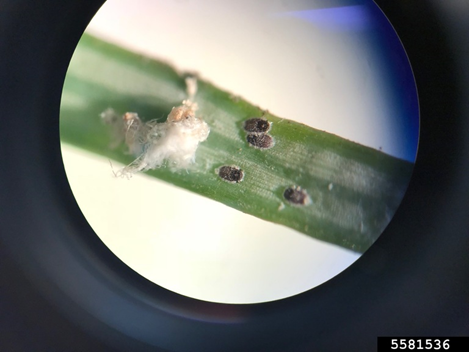
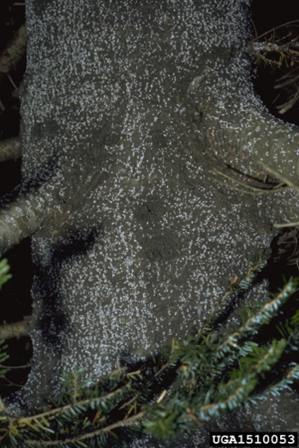
Images of infested trees
Early damage:

Later damage:
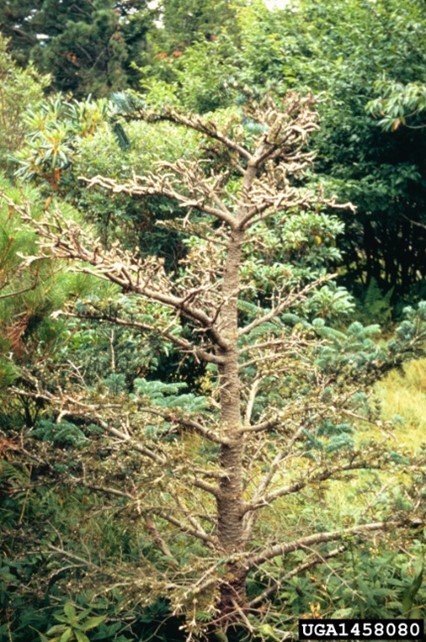
Look alikes:
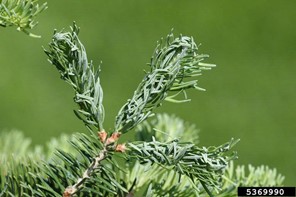
What can be done?
Management options for:
Homeowners –
Homeowners should scout their fir trees regularly for signs of BWA infestation. If BWA is discovered, report findings to your state government or local extension office. To prevent spread of BWA, consider removing and destroying any infested trees. This should be done in the winter, when the crawler stage is not present, to prevent accidental spreading. If a desirable tree becomes infested, chemical control is an option for individual trees. Contact pesticides can be applied while crawlers are present, in May through June and September through October. Some insecticidal soaps and oils may go through the waxy coating of the adults, but will be more effective against the crawler stage.
Adult BWA can live for a few months after trees are removed, therefore trees should be destroyed on site and firewood should never be moved.
Municipalities –
There are currently no effective, large scale BWA control methods. In infested stands, BWA can be managed with silviculture by strategic thinning and planting or selecting for resistant or non-host species. Harvesting infested trees should take place in the winter, when crawlers are not present to prevent accidental spreading. To protect high value individuals, contact pesticides can be applied while crawlers are present in May through June and September through October.
Regulatory information
Michigan is the only U.S. state with BWA quarantine in place. This exterior quarantine prohibits the entry into Michigan of any living form of BWA and any true fir (Abies spp.) tree as nursery stock or forest products.
Who to contact
-
Maine —
- Department of Agriculture, Conservation and Forestry
- Insect and disease reporting website
- Email: foresthealth@maine.gov
- Phone: (207) 287-2431
- University of Maine Cooperative Extension
- Phone: 207.832.0343 or 1.800.244.2104
- Email: extension@maine.edu
- Department of Agriculture, Conservation and Forestry
-
New Hampshire —
- Division of Forests and Land – Invasive Pest or Disease Reporting Form
- Phone: (603) 271-2214
-
University of New Hampshire Cooperative Extension —
- Phone: (603) 862-1520
-
Vermont —
- Department of Forests, Parks and Recreation
- Phone: 802-505-8259
- Email: Savannah.Ferreira@vermont.gov
- University of Vermont Extension
- Ginger Nickerson
- Phone: (802) 476-2003
- Email: ginger.nickerson@uvm.edu
- Ginger Nickerson
- Department of Forests, Parks and Recreation
-
New York —
- Department of Environmental Conservation - Division of Lands and Forests
- Phone: 518-402-9425
- Email: landsforests@dec.ny.gov
- Cornell Cooperative Extension
- David Gray Cox
- Phone: 518-234-4303 (x119)
- Email: dgc23@cornell.edu
- David Gray Cox
- Department of Environmental Conservation - Division of Lands and Forests
-
North Carolina —
- North Carolina Forest Service
- Phone: (919) 857-4801
- North Carolina State University Extension
- Kelly Oten - Extension Specialist, Forest Health
- Phone: (919) 515-5573
- Email: klfelder@ncsu.edu
- Kelly Oten - Extension Specialist, Forest Health
- North Carolina Forest Service
-
Virginia —
- Virginia Department of Forestry - Forest Management and Health
- Virginia Cooperative Extension - Woodland Management
- Jennifer Gagnon
- Email: jgagnon@vt.edu
- Jennifer Gagnon
-
West Virginia —
- West Virginia University Extension
- Dave McGill - Extension Specialist – Forest Resources
- Phone: 304-293-5930
- Email: DMcGill@wvu.edu
- Dave McGill - Extension Specialist – Forest Resources
- West Virginia Division of Forestry
- Phone: (304) 558-2788
- West Virginia University Extension
-
Tennessee —
- Department of Agriculture - Protect Tennessee Forests Program
- Phone: (615) 837-5520
- Email: Protect.TNForests@tn.gov
- University of Tennessee Extension – Forestry
- Dr. David Mercker - Extension Specialist
- Phone: 731-425-4703
- Email: dcmercker@utk.edu
- Dr. David Mercker - Extension Specialist
- Department of Agriculture - Protect Tennessee Forests Program
-
California —
- California Department of Food and Agriculture
- Pest Hotline: 1-800-491-1899
- Email: phppsinfo@cdfa.ca.gov
- Website: https://www.cdfa.ca.gov/plant/reportapest/form/reportapestform.pdf
- California Department of Food and Agriculture
-
Washington —
- Washington State Department of Natural Resources
- Jennifer Watkins - Assistant Division Manager
- Phone: (360) 338-1688
- Email: jennifer.watkins@dnr.wa.gov
- Jennifer Watkins - Assistant Division Manager
- Washington State University Urban IPM
- Phone: (253) 445-4577
- Email: urban.ipm@wsu.edu
- Washington State Department of Natural Resources
-
Oregon —
- Oregon Department of Agriculture
- Insect Pest Prevention and Management
- Phone: (503) 986-4636
- Alternative Phone: 1-800-525-0137
- Email: plant-entomologists@oda.oregon.gov
- Insect Pest Prevention and Management
- Oregon State University Extension Services
- Vaughn Walton - Entomologist
- Phone: (541) 737-3464
- Email: waltonv@hort.oregonstate.edu
- Vaughn Walton - Entomologist
- Oregon Invasive Species Online Hotline
- https://oregoninvasiveshotline.org/
- Oregon Department of Agriculture
-
Idaho —
- Idaho Department of Lands
- Phone: (208) 769-1525
- Website: https://www.idl.idaho.gov/about-us/supervisory-areas/
- University of Idaho Extension
- Phone: (208) 885-6356
- Email: extfor@uidaho.edu
- Idaho Department of Lands
-
Montana —
- Montana State University Extension Forestry
- Phone: (406) 243-2773
- Email: extensionforestry@montana.edu
- Montana Department of Natural Resources and Conservation
- Forestry Division Phone: (406) 542-4300
- Montana State University Extension Forestry
-
Utah —
- Utah Department of Agriculture and Food
- Kris Watson - State Entomologist
- Phone: (801) 982-2311
- Kris Watson - State Entomologist
- Plant Industry Division
- Phone: (801) 982-2305
- Email: udaf-plantdivision@utah.gov
- Utah State University Extension
- Diane Alston - Entomology Specialist
- Phone: (435) 797-2516
- Email: Diane.Alston@usu.edu
- Diane Alston - Entomology Specialist
- Utah Department of Agriculture and Food
-
Alaska —
- Alaska Department of Natural Resources
- Division of Forestry - Forest Health Program
- Phone: (907) 269-8460
- Helge Eng - State Forester and Director
- Phone: (907) 269-8463
- Email: helge.eng@alaska.gov
- Division of Forestry - Forest Health Program
- University of Alaska Fairbanks Cooperative Extension Service
- Phone: 907-474-5211
- Email: ces@alaska.edu
- Reporting Website
- Alaska Department of Natural Resources
-
Michigan —
- MSU Plant & Pest Diagnostics email pestid@msu.edu or call 517-355-4536 or visit https://www.canr.msu.edu/pestid/index
- Michigan Department of Agriculture and Rural Development: Email MDA-Info@michigan.gov, go to the Invasives link.
- Midwest Invasive Species Information Network’s (MISIN): use the online reporting tool or download the MISIN smartphone app and report from your phone: http://www.misin.msu.edu/tools/apps/#home, https://www.misin.msu.edu/report/misin/?project=misin
- Midwest Invasive Species Information Network (MISIN)
-
USDA Forest Service —
- Northern Research Station
- Phone: (608) 231-9318
- Website: https://www.nrs.fs.fed.us/
- Pacific Northwest Research Station
- Phone: (503) 808-2100
- Website: https://www.fs.usda.gov/pnw/
- Pacific Southwest Research Station
- Phone: (510) 883-8830
- Email: SM.FS.psw-comms@usda.gov
- Website: https://www.fs.fed.us/psw/
- Rocky Mountain Research Station
- Phone: (970) 498-1100
- Website: https://www.fs.usda.gov/rmrs/
- Southern Research Station
- Phone: 828-257-4832
- Website: https://www.srs.fs.usda.gov/
- USDA APHIS State Plant Heath Directors by State
- Northern Research Station